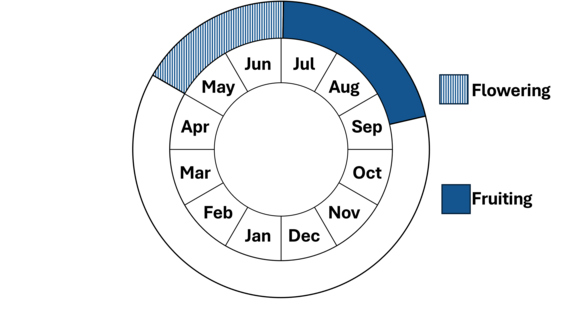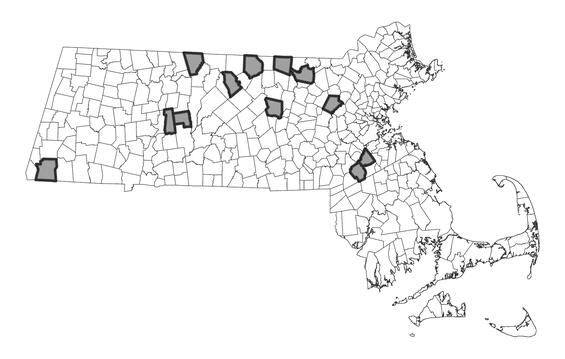- Scientific name: Scheuchzeria palustris
- Species of Greatest Conservation Need (MA State Wildlife Action Plan)
- Endangered (MA Endangered Species Act)
Description
Pod-grass (Scheuchzeria palustris) is an erect rush-like plant of open peatlands, with a cluster of greenish flowers, sheathing opposite leaves, and a zig-zag stem. Pod-grass, which blooms from May until July, is the sole species in its family (Scheuchzeriaceae).
The zig-zag stem of pod-grass grows 23-46 cm (9-18 in) in height. The leaves are alternate, erect, and linear; they are 5-30 cm (2-12 in) in length and about 0.25 cm or less (0.1 in or less) in width. The stem leaves are well-separated, whereas the basal leaves are tightly clustered, with dilated bases that sheath the lower stem. The inflorescence consists of three to ten racemes of yellow-green flowers, each with three tepals (undifferentiated outer flower parts, similar to sepals and petals). Fruits are 0.5-0.7 cm (0.2–0.3 in), and consist of three diverging follicles, or “pods,” each with one or two small black seeds. A good time to survey this species is from early July to early September, when the conspicuous fruit is present.
Pod-grass has unique characteristics, and there are no other species in its genus or family. Species of the Arrow-grass family (Juncaginaceae) are closely related, but they have basal leaves only (no stem leaves). Some rushes (family Juncaceae) are superficially similar, but rushes have two perianth whorls (analogous to sepal and petals) rather than one, and the flowers are often subtended by leafy bracts.
Life cycle and behavior

Population status
Pod-grass is listed under the Massachusetts Endangered Species Act as Endangered. All listed species are legally protected from killing, collection, possession, or sale, and from activities that would destroy habitat and thus directly or indirectly cause mortality or disrupt critical behaviors. Massachusetts Natural Heritage & Endangered Species Program database has 25 records from 9 counties across the state. Ten of those records are within the last 25-year period.

Distribution in Massachusetts
1999-2024
Based on records in the Natural Heritage Database
Distribution and abundance
The range of Pod-grass extends across much of the northern United States (north of Virginia, Indiana, Wyoming, and California); and discontinuously in New Mexico and Canada (minus Nunavut and Yukon Territories). Pod-grass is also rare in Alaska, Connecticut, Idaho, Montana, New York, North Dakota, Ohio, Pennsylvania, Rhode Island, Wyoming, Alberta, and Labrador. It is historically known from Illinois, Iowa, and West Virginia, and its status is under review in several states.
Habitat
Pod-grass inhabits open acidic peatlands, often in areas that are dominated by sedges and sphagnum mosses (Sphagnum spp.). Associated species include tawny cotton-grass (Eriophorum virginicum), white beak-sedge (Rhynchospora alba), slender woolly-fruited sedge (Carex lasiocarpa var. americana), large cranberry (Vaccinium macrocarpon), water-willow (Decodon verticillatus), leatherleaf (Chamaedaphne calyculata), and pitcher-plant (Sarracenia purpurea).
Healthy habitats are vital for supporting native wildlife and plants. Explore habitats and learn about conservation and restoration in Massachusetts.
Threats
Threats to pod-grass include changes in the water quality due to inputs of road salt or nutrients from septic systems or adjacent fertilized land (residential areas, golf courses, agricultural fields); alterations to the natural hydrologic regime that affect water levels; invasions by exotic invasive plant species such as common reed (Phragmites australis ssp. australis), glossy buckthorn (Frangula alnus), and purple loosestrife (Lythrum salicaria); trampling at sites with heavy recreational use; and over-shading from dense growth of associated shrubs, such as leatherleaf.
Conservation
As with many rare species, the exact management needs of pod-grass are not known. Protecting the habitat of this species requires maintaining high water quality and natural, stable water levels; this may involve restricting use of road salt and fertilizers in adjacent areas and regulating water drawdown if the wetland has a dam or is used for irrigation.
Pod-grass habitat sites should be regularly monitored to enable early detection of invasive exotic species and to determine if the plants are becoming over-shaded. Acidic, low-nutrient peatlands are generally inhospitable to many exotic species, but invasions can occur, particularly on the edges where nutrient levels are slightly higher, and in areas with anthropogenic nutrient inputs. At sites where pod-grass is becoming over-shaded by dense shrubs, careful thinning can be implemented to restore an open character to the habitat.
To avoid inadvertent harm to rare plants, all active management of rare plant populations (including invasive species removal) should be planned in consultation with MassWildlife’s Natural Heritage & Endangered Species Program.
Contact
| Date published: | May 9, 2025 |
|---|